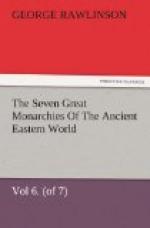The people engaged in this great movement are called, in a general way, by the classical writers, Sacse, or Scythse—i.e. Scyths. They consisted of a number of tribes, similar for the most part in language, habits, and mode of life, and allied more or less closely to the other nomadic races of Central and Northern Asia. Of these tribes the principal were the Massagetse ("great Jits, or Jats"), who occupied the country on both sides of the lower course of the Oxus; the Dahse, who bordered the Caspian above Hyrcania, and extended thence to the latitude of Herat; the Tochari, who settled in the mountains between the upper Jaxartes and the upper Oxus, where they gave name to the tract known as Tokhar-estan; the Asii, or Asiani, who were closely connected with the Tochari, and the Sakarauli (Saracucse?), who are found connected with both the Tochari and the Asiani. Some of these tribes contained within them further sub-divisions; e.g. the Dahse, who comprised the Parni (or Apariii), the Pissuri, and the Xanthii; and the Massagetse, who included among them Chorasmii, Attasii, and others.
The general character of the barbarism in which these various races were involved may be best learnt from the description given of one of them, the Massagetae, with but few differences, by Herodotus and Strabo. According to this description, the Massagetse were nomads, who moved about in wagons or carts, accompanied by their flocks and herds, on whose milk they chiefly sustained themselves. Each man had only one wife, but all the wives were held in common. They were good riders and excellent archers, but fought both on horseback and on foot, and used, besides their bows and arrows, lances, knives, and battle-axes. They had little or no iron, but made their spear and arrow-heads, and their other weapons, of bronze.




